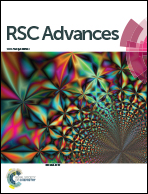Fluorescence response of a thiazolidine carboxylic acid derivative for the selective and nanomolar detection of Zn(ii) ions: quantum chemical calculations and application in real samples†
Abstract
A thiazolidine carboxylic acid derivative (L) was conveniently synthesized and characterized by spectral techniques and single crystal X-ray crystallography. The complexation of L with zinc (L–Zn2+) was studied by scanning electron microscopy (SEM) and energy dispersive spectroscopy (EDS) and further substantiated by 1H NMR and ESI-MS analysis. The L showed excellent specificity and sensitivity towards a zinc-induced fluorescence response by forming a 1 : 1 complex (Job's plot) in a 95% (v/v) water–methanol mixture. The presence of zinc ions causes ∼40 fold fluorescence enhancement at 481 nm (quantum yield, Φ = 0.19) and can be detected with the naked eye under a UV-lamp. The L can detect Zn2+ in nanomolar levels (13.90 nM) with good tolerance in the presence of other interfering metal ions. The reversibility of L–Zn2+ complexation was checked by EDTA titration. The maximum fluorescence enhancement by Zn2+ binding of L was observed in the pH range of 7.0–9.0. The dissociation constants of L and the stability constant of the L–Zn2+complex in 0.15 M NaClO4 were determined by pH metrically. Theoretical calculations were done using density functional theory (DFT) to support the above findings. L was successfully applied for the determination of Zn2+ in water samples. The compound (L) detects the presence of, Klebsiella pneumoniae and E. coli in water samples.


 Please wait while we load your content...
Please wait while we load your content...